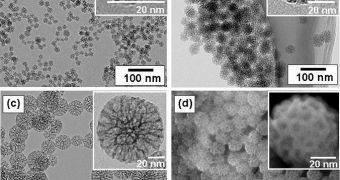Scientists have been trying to produce metallic nanoparticles able to withstand large temperatures for a long time, but their efforts have thus far been in vein. These small structures could come in handy as catalysts for hydrogen production, or as active components in new catalysts systems, which might see cars emit less pollution than they do now. Researchers at the University of Pittsburgh have just demonstrated high-temperature stability in nanoparticles for the first time, opening the way for these applications to finally be set into motion.
Metallic nanoparticles are, in fact, the next-generation material that everyone has been talking about. However, this field of research has been plagued by the heat vulnerability for many years. “The natural instability of particles at this scale is an obstacle for many applications, from sensors to fuel production. The amazing potential of nanoparticles to open up completely new fields and allow for dramatically more efficient processes has been shown in laboratory applications, but very little of it has translated to real life because of such issues as heat sensitivity,” explains PU Swanson School of Engineering associate professor and CNG Faculty Fellow of chemical and petroleum engineering, Gotz Veser.
“For us to reap the benefits of nanoparticles, they must withstand the harsh conditions of actual use,” he adds. The new work is detailed in the November 29 issue of the respected scientific journal Nature Materials. The lead author is Anmin Cao, a postdoctoral researcher in Veser's lab. Funding for the investigation came from the National Energy Technology Laboratory, a division of the US Department of Energy (DOE) Office of Fossil Energy. Additional funds were provided by the Office of Basic Energy Sciences and the National Science Foundation (NSF).
The team focused its work on 5-nanometer particles, which are known to fuse together at around 600 degrees Celsius. This temperature is lower than that used in many industrial processes that could benefit from the small structures' action. By using a platinum / rhodium alloy, the team was able to demonstrate 4.3-nanometer particles that are able to withstand prolonged methane combustion at more than 850 degrees Celsius. Some of the particles remained stable even after the temperature was lifted to 950 degrees Celsius. Admittedly, most of them had already expanded by that point.

 14 DAY TRIAL //
14 DAY TRIAL //